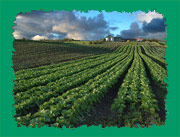Renewable EnergySustainability-SMART! Home
Biomass
Biomass is organic matter, such as agricultural and animal waste, that is collected to create energy in the form of electricity, heat, steam, and fuels. Biomass can be burned in an incinerator to heat water to make steam, which turns a turbine to make electricity. It can also be converted into a liquid or gas, which can be burned to do the same thing.
Biomass includes energy crops like wood, grains, kelp, and beets grown primarily for use as a fuel. Energy crops are renewable, but some, like trees, take a long time to grow. For example, farmers can grow trees on some of their land instead of wheat or other kinds of food. The wood is harvested regularly, cut into small chips, and burned to provide heat or run small electric power plants.
Another type of biomass is methane gas, a by-product of decay in landfills. As garbage rots in the ground, it gives off gases that can be collected and burned to produce heat. These gases can also be burned to heat water into steam, which can be used to turn a turbine and generate electricity.
Before the Industrial Revolution, humans relied on biomass in the form of wood for nearly all their energy needs. Today, biomass provides about 23% of the United States' renewable energy production, and biomass and waste fuels made up 2% of total U.S electricity generation in 2016. (*Source: U.S. Energy Information Administration.) |




